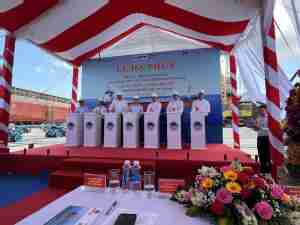Iron Ore Routed as `Center of Gravity’ Seen in Constant Decline
By: | May 04 2017 at 08:11 AM | Maritime
Iron ore is in full-scale retreat, with futures in China plunging to end limit-down on investor concern about the outlook for demand in the world’s top user, fresh signs of burgeoning supply from Australia and the hostile backdrop of a broad-based sell-off in base metals.
“Iron ore’s center of gravity is constantly moving lower,” said Zhao Chaoyue, an analyst at China Merchants Futures Co. “Concerns about the glut have always been there. Port stockpiles are maintaining near a record and there’s a consensus that supply will go on expanding, especially in the second half.”
The raw material sank into a bear market last month amid concern supplies are rising just as China’s mills enter a weaker period for demand. The steel industry’s purchasing managers index for April fell below 50, signaling a return to contraction, according to data at the weekend. And figures Thursday showed shipments from Port Hedland, Australia’s main terminal, rose to the highest this year even as holdings at ports in China remain near a record high.
“There is still room for iron ore to decline further amid oversupply,” the China Iron & Steel Association, which groups top mills, said in a statement on its website, as miners’ shares sank. “Steel output fell slightly in April. With imports, port stockpiles remaining at high levels, oversupply isn’t easing.”
On the Dalian Commodity Exchange, ore for September delivery lost 7.3 percent, the maximum daily drop allowed, while in Singapore, SGX AsiaClear futures fell as much as 9.1 percent to $60.37 a ton. Spot ore with 62 percent content in Qingdao slid 5.1 percent to $65.20 a dry ton, extending this year’s decline to 17 percent, according to Metal Bulletin Ltd.
The sell-off has hurt miners as industrial metals prices also tumbled. In London, BHP Billiton Ltd. fell 2.7 percent and Rio Tinto Group dropped 1.4 percent. Fortescue Metals Group Ltd. earlier sank 4.8 percent to below A$5 in Sydney trading after closing at A$7.17 as recently as Feb. 21. The trio are Australia’s biggest shippers. Elsewhere, Kumba Iron Ore Ltd. dipped 3.4 percent in Johannesburg.
Steel was also hammered. On the Shanghai Futures Exchange, reinforcement bar ended 6.4 percent lower, paring its advance this year to 2.2 percent. Daily volume for the most-active contract surged above 10 million lots, or 100 million tons of steel—about an eighth of what the nation produces in a year—according to bourse data compiled by Bloomberg. Hot-rolled coil fell for a third straight day, ending limit-down.
While both iron and steel benefited last year and in 2017’s first quarter from a credit-and-infrastructure splurge in China, there’s now concern consumption will ease as the impact fades. Nevertheless, Rio Tinto isn’t worried about China, Chief Executive Officer Jean-Sebastien Jacques said on Thursday.
Rio’s Optimism
“The indications are positive for 2018 as well, but it’s early days,” Jacques told reporters after an annual meeting in Sydney, revealing that he’s visited the nation five times in the past nine months. “Are we concerned about the Chinese economic health? The answer is ‘no’,” he said.
Iron ore’s retreat has come after banks, some miners and Australia flagged prospects for weakness. Australia put the spotlight on rising production in its latest official outlook, while BHP has forecast that Brazil—the second-biggest exporter—will deliver about 100 million tons of additional supply in 2018, including the ramp-up of Vale SA’s S11D mine.
Exports from Port Hedland—which handles cargoes for miners including BHP and Roy Hill Holdings Pty—climbed to 42.3 million tons in April, the Pilbara Ports Authority said on Thursday. That’s a record for the month, and the third-highest figure ever. Year-to-date exports are 6.6 percent more than in 2016.
Port Holdings
The rise in shipments in recent months, as well as record steel production in China, has helped to boost stockpiles at ports in China. After peaking at a record 132.5 million tons in March, the holdings have held near that level, according to Shanghai Steelhome E-Commerce Co.
Iron ore’s weakness on Thursday came after base metals posted the biggest daily plunge this year, buffeted by concern about the outlook for demand in China and a stronger dollar. Copper tumbled on Wednesday after stockpiles surged, while nickel sank as supply concerns eased in the Philippines.









